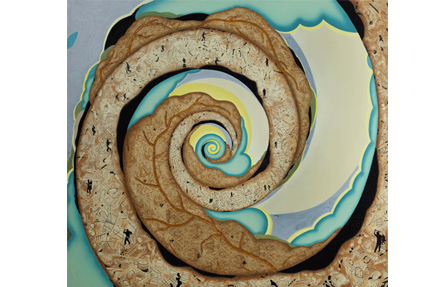
Jagannath Panda. Courtesy: Vadehra Art Gallery. New Delhi.
K. Satchidanandan
(Translated from the Malayalam by the poet.)
The day was calm. Three of
Gandhi’s visitors stepped forward:
an expecting Mahar woman, almost a girl,
from the Maratha region, a young dumb Bhili youth
from Gandhi’s own place, his body burnt black,
a Korba from mid-India on crutches,
still carrying his bow.As soon as Gandhi, filling post-cards
with his small hand, gestured to them to talk,
the woman pointed to her belly and said:
“You are responsible for this.”
Gandhi just smiled his Zen smile
as she went on: “ I could have cut him
to pieces, but you taught us to loathe violence.”Now the Bhil spoke in sounds and gestures:
His landlord who had trapped him in debts
and enslaved him, tied him to a tree,
cut off his tongue and burnt him all over
for having drawn water from his well.
He had endured it all as to resist
would have meant violence.The Korba lowered his bow: “ With this
bow and arrow I could’ve killed that leopard
that had left me lame; but what do we have
once we give up non-violence?”Gandhi dropped his pen and told his
faithful disciples: “You have taken me literally.
Here violence was done by that rapist,
the landlord and the leopard. Of these
only the scared leopard was unaware that
he was committing violence. He was
just following his instinct. But the other two
deserved no mercy. Dear child, if teeth and nails
were of no help, you could’ve saved your honour
with your sickle or the kitchen-knife.
Gandhi now turned to the Bhil and spoke in gestures:
“Your axe would’ve helped where words failed you.”
“Then what about non-violence”, asked the Korba.
“Nowhere have I said that it is wrong
to harm the aggressor in order to save
your life or honour; only it should be
the very last resort..”
An onlooker now
posed a question: “Then why did you condemn
Bhagat Singh and his comrades?” “Simple.
I knew who I was fighting and we had
better chances if we abjured violence.”“Is not fasting violence too?”, asked another,
“you torment your body and blackmail your enemy.”
“Look here: there is no iron-wall between violence
and non-violence, and no value in life is absolute.”The woman stared at her belly, the Bhil youth
at his near-charred body and the Korba
at his leg-stumps: “ We didn’t understand.”
A tender voice responded from within the
woman’s womb: “ I understood.”
Notes:By permission of K. Satchidanaandan. (From http://poetry.sangamhouse.org/
). Satchidanandan poet, art critic, essayist and public intellectual writes in both English and Malayalam. He resigned from the executive board of the SahityaAkademi in protest against the Akademi’s failure to “stand with writers and uphold the freedom of expression guaranteed by the Constitution of India” in 2015. Read the full letter here: http://indianculturalforum.in/2015/10/18/october-17-2015-letter-from-k-satchidanandan-to-the-sahitya-akademi/

Leave a Reply